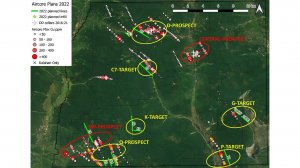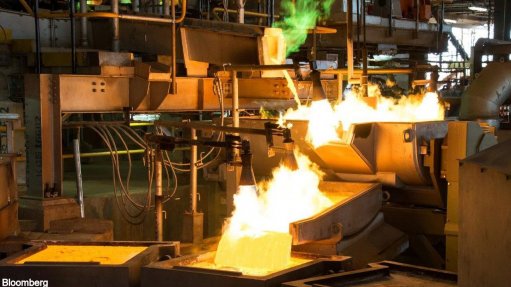Aircore drilling under way at Pangeni



PANGENI EXPLORATION Location map for planned 2022 aircore drilling lines at priority prospects and targets
PROSPECTIVE REGION The openpit Sentinel copper mine is operated some 130 km to the northeast of Pangeni
TSX-V-listed precious and base metals exploration and development company BeMetals has started its 2022 exploration campaign at the Pangeni copper project on the western extension of the Central African Copperbelt in Zambia. Initial aircore results will be used to help determine targets for core drill testing that is expected to be completed before year-end.
The primary objective of this year’s exploration programme is to follow up with testing and extend the Q prospect area where last year’s diamond drilling programme intersected 4.14 m grading 0.62% copper in hole Q3-C1, which is importantly hosted in interpreted Katangan Supergroup sediments, explained the company in a June 29 announcement.
Field crews have been mobilised to Pangeni, where this year’s planned programme comprises about 4 000 m of shallow aircore drilling and about 1 400 m of diamond drilling to scope the scale potential of the Q and D prospects and test other targets that have a similar setting to the Q prospect.
The aircore holes will be spaced at various distances along the lines from 400-m- to 200-m- and 100-m-infill centres based upon field results and geological observations of the drill cuttings. This exploration programme is to be jointly funded by BeMetals and Japan, Oil, Gas and Metals National Corporation (Jogmec).
“We are very excited to be following up on last year’s encouraging results with a new $1.5-million exploration programme, funded pro rata by both BeMetals and Jogmec, to test the extent of copper mineralisation discovered at the Q and D prospects last year,” says BeMetals president and CEO John Wilton.
He adds that the Q prospect is of particular interest as last year’s drilling revealed significant copper mineralisation hosted in siltstones which are interpreted to be Katangan rocks in hole Q3-C1.
“Such Katangan units are well known to host some of the largest sediment-hosted copper deposits along the Zambian Copperbelt.”
BeMetals director Tom Garagan explains that, to date, BeMetals’ drilling campaigns have returned numerous intersections beneath the shallow sand cover with copper grades similar to that of Canada-based mining and metals company First Quantum Minerals’ Sentinel and gold and copper producer Barrick Gold’s Lumwana copper mines in the Zambian Copperbelt.
BeMetals is finding many of the mineralisation and geological relationships important for sediment-hosted deposits in this region and is targeting structures to find the feeder zones for the copper mineralisation discovered on the Pangeni property, he adds.
Q Target
Last year’s intersection of 4.14 m grading 0.62% copper from 92.36 m drilled depth in drill hole Q3-C1 is of specific interest as this zone of copper oxide mineralisation is hosted within siltstones interpreted to be part of the Katangan Supergroup.
These siltstones have been intersected in proximity to what is currently interpreted to be basement-hosted copper mineralisation at the SW prospect. Many of the world-class, sediment-hosted copper deposits and mines of the Central African Copperbelt occur in this same geological setting when coupled with favourable structural feeders for the copper mineralisation, explains BeMetals.
Based on last year’s geological results, complemented with interpretation of the geophysics for the project, the company expects the prospective target area of the structural and/or stratigraphic contact zone between the basement and the Katangan Supergroup units to be located between the Q3 target and SW prospect. Hole Q3-C1 is currently the highest follow-up priority target for this year. In addition, BeMetals will test targets P and G along strike from the Q prospect with both appearing to have similar prospective geological settings.
D Prospect
The company first discovered copper mineralisation at the D prospect near the end of 2019, and based on last year’s drilling results, this area remains an important target area for further exploration.
During past drilling campaigns, BeMetals intersected copper mineralisation in several drill holes at the D prospect, including holes D7-C1, D7-C2 and D3-C2. These drill holes returned meaningful and multiple copper intersections ranging from 0.5 m to 6 m in width and 0.32% to 0.58% copper in grade, with a 0.3% copper cutoff grade, and require further follow-up testing this year.
Thus far, copper mineralisation in this area extends for at least 1.2 km along the interpreted strike of the host rocks and remains completely open to extension in the south-west direction and down-dip. The aircore drilling, to date, to the north-east of the prospect has not identified drill targets in that direction but the relatively wide-spaced drill centres at 400 m do not rule out potential extensions in that area. There is also an untested aircore anomaly towards the north-western end of the D2 line.
Significant copper mineralisation has now been intersected in five of the six core drill holes completed at the D prospect. The copper grades in many of last year’s (D7-C1 and D7-C2) and previous drill holes are similar to those for operating large-scale copper mines in the Domes Region of the Zambian Copperbelt.
The Pangeni project is on the western extension of the Zambian Copperbelt in the Lufilian Arc, underlain by Katangan Supergroup metasediments situated unconformably on basement schists and gneisses, which are covered by a thin veneer of Kalahari sands. The openpit Sentinel copper mine is operated some 130 km to the north-east of Pangeni. Several major international mining companies have identified this region of the Zambian Copperbelt to be prospective for the discovery of tier one copper mines and are also conducting extensive exploration work in this area.
The Pangeni project property is geologically prospective for basement-hosted copper, sediment-hosted stratiform copper/cobalt, other domes region deposits and Kansanshi and Democratic Republic of Congo Copperbelt deposits.
Comments
Press Office
Announcements
What's On
Subscribe to improve your user experience...
Option 1 (equivalent of R125 a month):
Receive a weekly copy of Creamer Media's Engineering News & Mining Weekly magazine
(print copy for those in South Africa and e-magazine for those outside of South Africa)
Receive daily email newsletters
Access to full search results
Access archive of magazine back copies
Access to Projects in Progress
Access to ONE Research Report of your choice in PDF format
Option 2 (equivalent of R375 a month):
All benefits from Option 1
PLUS
Access to Creamer Media's Research Channel Africa for ALL Research Reports, in PDF format, on various industrial and mining sectors
including Electricity; Water; Energy Transition; Hydrogen; Roads, Rail and Ports; Coal; Gold; Platinum; Battery Metals; etc.
Already a subscriber?
Forgotten your password?
Receive weekly copy of Creamer Media's Engineering News & Mining Weekly magazine (print copy for those in South Africa and e-magazine for those outside of South Africa)
➕
Recieve daily email newsletters
➕
Access to full search results
➕
Access archive of magazine back copies
➕
Access to Projects in Progress
➕
Access to ONE Research Report of your choice in PDF format
RESEARCH CHANNEL AFRICA
R4500 (equivalent of R375 a month)
SUBSCRIBEAll benefits from Option 1
➕
Access to Creamer Media's Research Channel Africa for ALL Research Reports on various industrial and mining sectors, in PDF format, including on:
Electricity
➕
Water
➕
Energy Transition
➕
Hydrogen
➕
Roads, Rail and Ports
➕
Coal
➕
Gold
➕
Platinum
➕
Battery Metals
➕
etc.
Receive all benefits from Option 1 or Option 2 delivered to numerous people at your company
➕
Multiple User names and Passwords for simultaneous log-ins
➕
Intranet integration access to all in your organisation




















